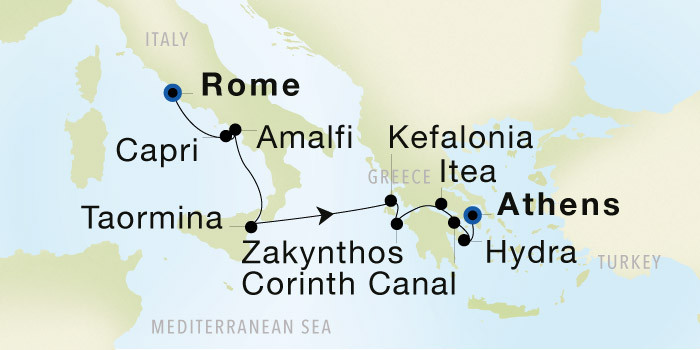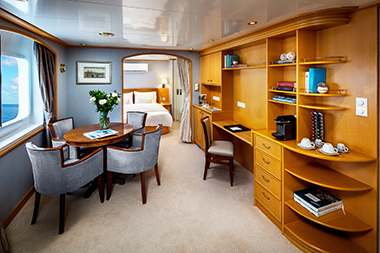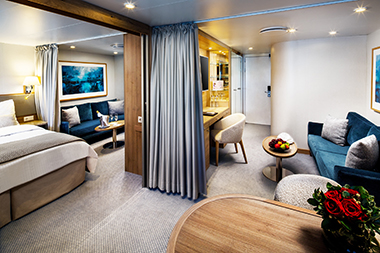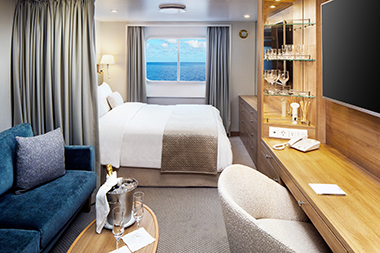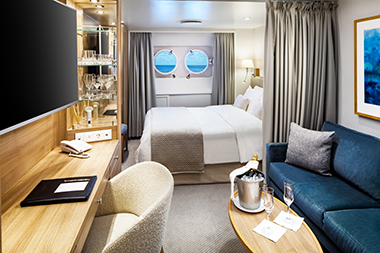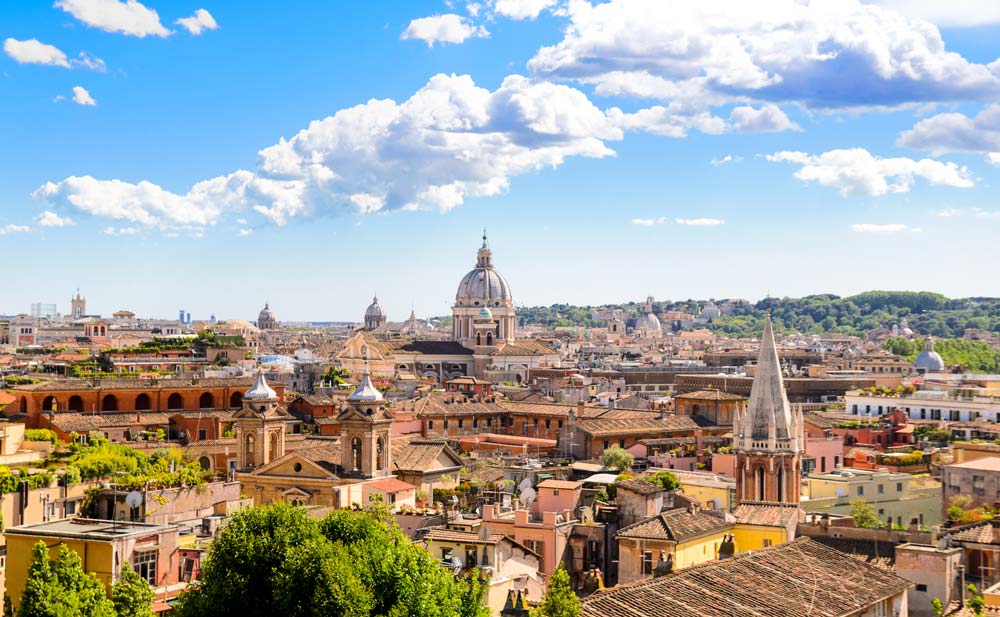
Civitavecchia is a major port located in Rome, primarily utilized for maritime transportation of goods, as well as a fishing port. The commune’s name means “ancient town” and is one of the “Motorways of the Sea” in the Mediterranean, functioning as one of the main links between the mainland of Italy and Sardinia. The ancient name of the port was “Centumcellae,” first mentioned in a letter written by Pliny the Younger in 107 A.D., although scholars debate on whether the name was about the number of rooms of the Trajan Villa, or the number of natural creeks on the coast. Civitavecchia is a part of the Lazio Territory, an area which was confirmed to have social groups since pre-historic times, and the modern town was built over a pre-existing settlement of the Etruscan people in 107-108 B.C.E. (who debated to have founded Rome). In the beginning of the 2nd century, the harbor and town of Centumcellae were simultaneously developed by Emperor Trajan in the territory of Aquae Tauri. As the town became more popular for ships traveling westbound, the Thermal Baths were constructed on the hill of Ficoncella. Centumcellae flourished in the Imperial Age, and by 538 A.D., it had become a Byzantine stronghold. In 728 A.D., it became a member of the Papal States. The Saracens raided Centumcellae many times in the 9th century, prompting Pope Leo VII to have a newer and more secure settlement built by 854. The town, then known as Civita Vetula, was under the rule of several lords, and the Popes temporarily lost control during the French Rule in 1798-1815. In 1870 it entered the Kingdom of Italy. Civitavecchia was severely damaged during WWII, destroying many of the ancient monuments including Forte Michelangelo, which would be rebuilt in the 1950’s. Popular points of interest include the Forte Michelangelo, Terme Taurine, and Cattedrale di San Francesco. There is a wealth of Roman and Vatican architecture and tourists are encouraged to visit many of the museums and take the cultural tours available in this important sea port.
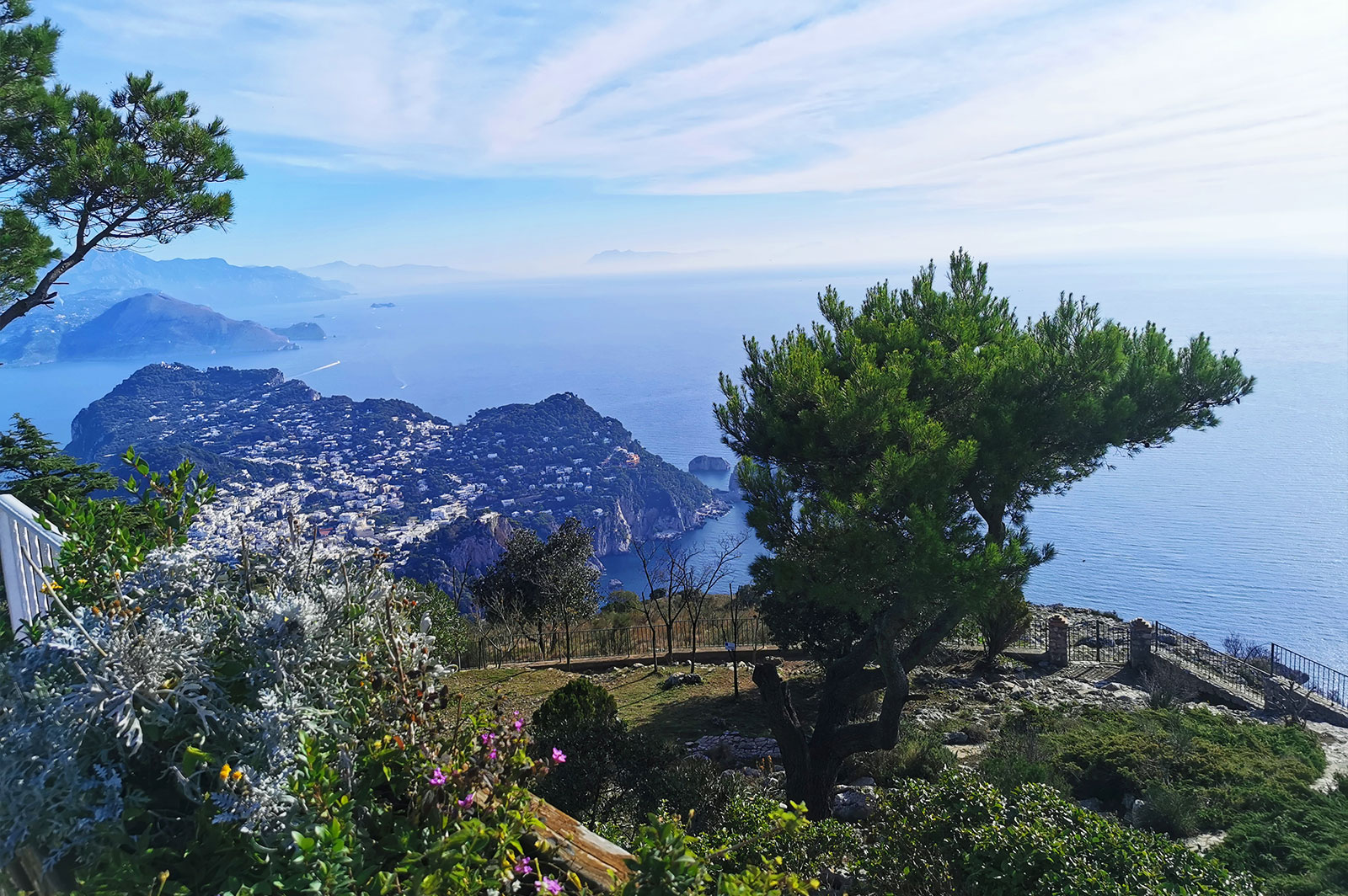
Sitting pretty in the Gulf of Naples, just off the Sorrentine Peninsula, the island of Capri is well known today for its breathtaking landscapes and upscale beach resorts. The island has two harbors, Marina Piccola and Marina Grande. While human presence on the island can be dated back to the Neolithic and the Bronze Age, it was Emperor Augustus who most famously developed Capri by building villas, temples, and planted gardens. Popular to both visitors and native Italians alike, Capri is known for its boutique hotels, trendy restaurants, and annual international film festival, and is a favorite yachting destination. The island also offers many historic landmarks and highlights, including Grotta Azzurra, Villa Jovis, Giardini di Augusto, Certosa di San Giacomo, Villa San Michele di Axel Munthe, and the uniquely shaped Faraglioni Rocks. Mt. Solero marks the highest point of Capri, at 589 meters (about 1932 ft) at its peak. There is also a statue of Emperor Augustus on the mount, who first landed on Capri, over 900 species of vegetation, and, of course, incredible views. Two different hiking routes lead up the mountain and are worthy of exploration. On many itineraries, SeaDream yachts dock alongside in Capri until midnight, allowing guests to step off the yacht and into Capri with ease, without tendering ashore—a unique experience due to the intimate size of our yachts. For those who may not be familiar with the island, Capri offers a sophisticated charm that comes alive in the evening. A guest favorite includes boarding the funicular that runs between the port in Marina Grande and the Piazzetta in Capri town above, where incredible views, buzzing bistros, and luxe boutiques await.
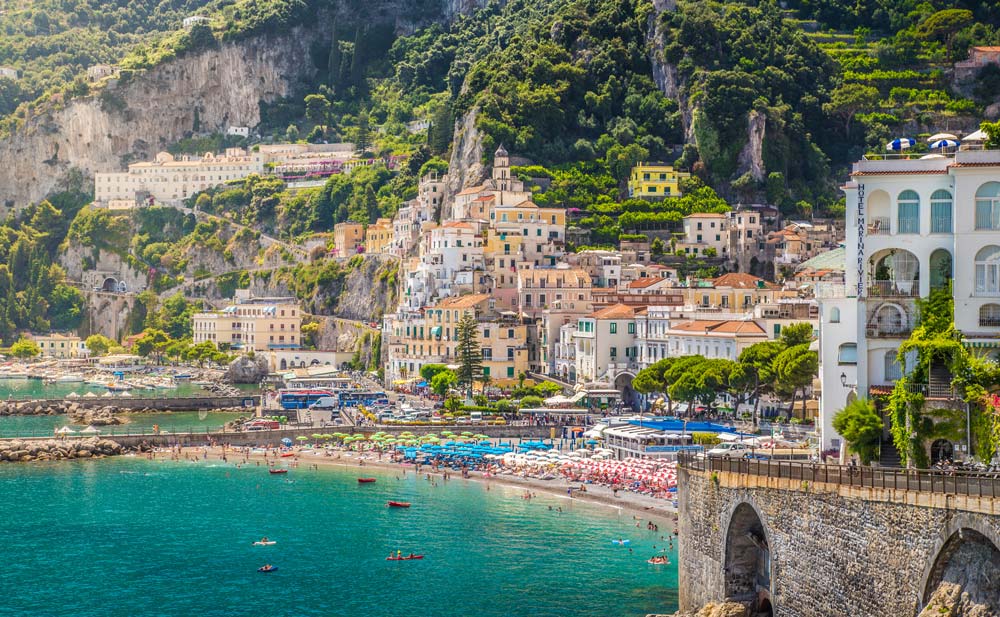
Amalfi is a picturesque town in the province of Salerno, in the Campania region of Italy. With its incredible views, it is the central town that makes up the very famous and UNESCO awarded Amalfi Coast (Costiera Amalfitana). Amalfi sports some impressive medieval architecture including; its cathedral of Sant'Andrea (St. Andrew), the church tower, the convent of the Cappuccini, founded by the Amalfitan Cardinal Pietro Capuano. They richly represent the artistic movement prevailing in Southern Italy. From Amalfi, we have created two exciting land adventures for you. One to Scenic Ravello and the other to Fascinating Pompeii. You may also choose to play from the yacht’s marina (Permission and conditions pending) or go on a very scenic hike with one of the officers.
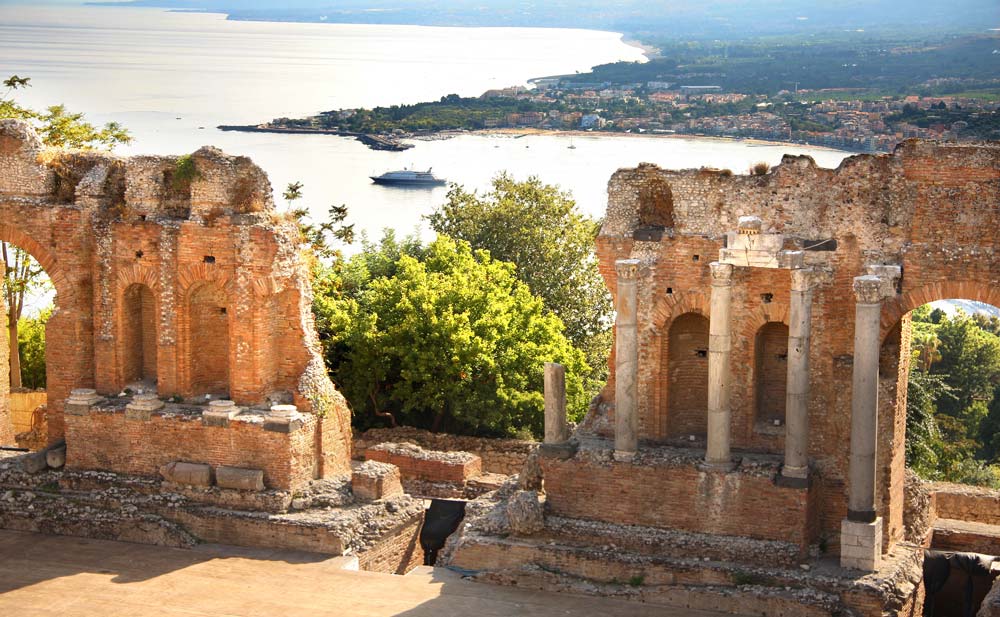
SeaDream yachts anchor in the bay of Giardini Naxos and offer fantastic views of recently awarded UNESCO Natural Site of Mt. Etna (2013) as well as Taormina perched on the cliffside. Shuttle bus service has been arranged to transport guests from Giardini Naxos to the entrance gate of Taormina town up to Castelmola which provides amazing views of the surrounding areas. Perhaps the “must do” adventure here would be to ascend Mt. Etna with your fellow SeaDreamers. Kindly check the Land Adventure tab for the specifics. Other options include an incredible and authentic feast at the Godfather Villa. As we are anchored and if conditions allow, we will offer water sports both in the morning and in the afternoon.
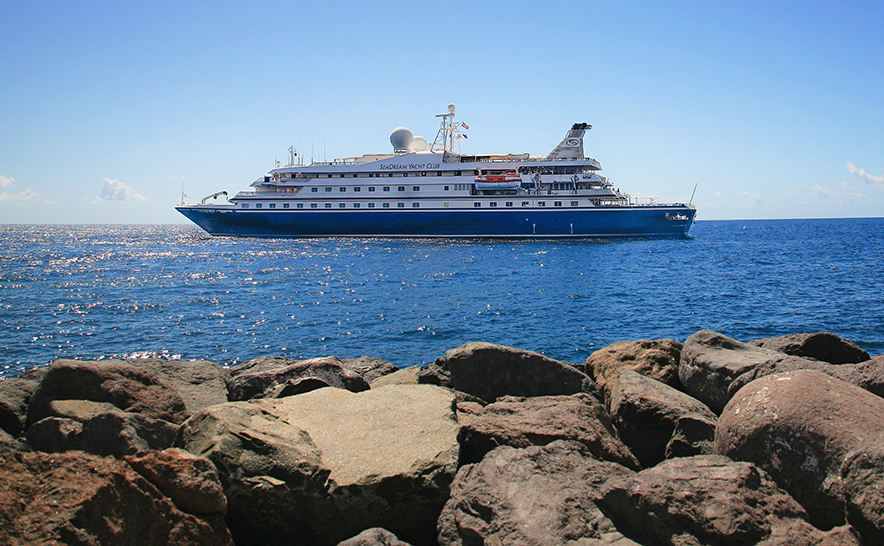
The Ionian Sea is a fanning bay of the Mediterranean, marked by the sole of Italy’s boot and the western coasts of Albania and Greece. Hugging the Greek shores, the Ionian Islands, including Corfu, were once called the Heptanesus, or the “Seven Islands.” As a key passageway to the Adriatic, these fabled waters have witnessed imperial and royal navies intent on conquest; Rome, Byzantium, Venice, France and Great Britain all sent fleets here in the name of gods, kings, and emperors. One goddess conquered the sea on her own: After being turned into a white heifer by her lover Zeus, Io swam across the sea to Egypt, where the god promised to return her to human form. Locals may tell you these glimmering waters were named for her—or perhaps for Ionius, son of Adrias, who gave the sea to the north its name. One thing is certain: These azure waters kiss some of Europe’s most beautiful and beloved shores.
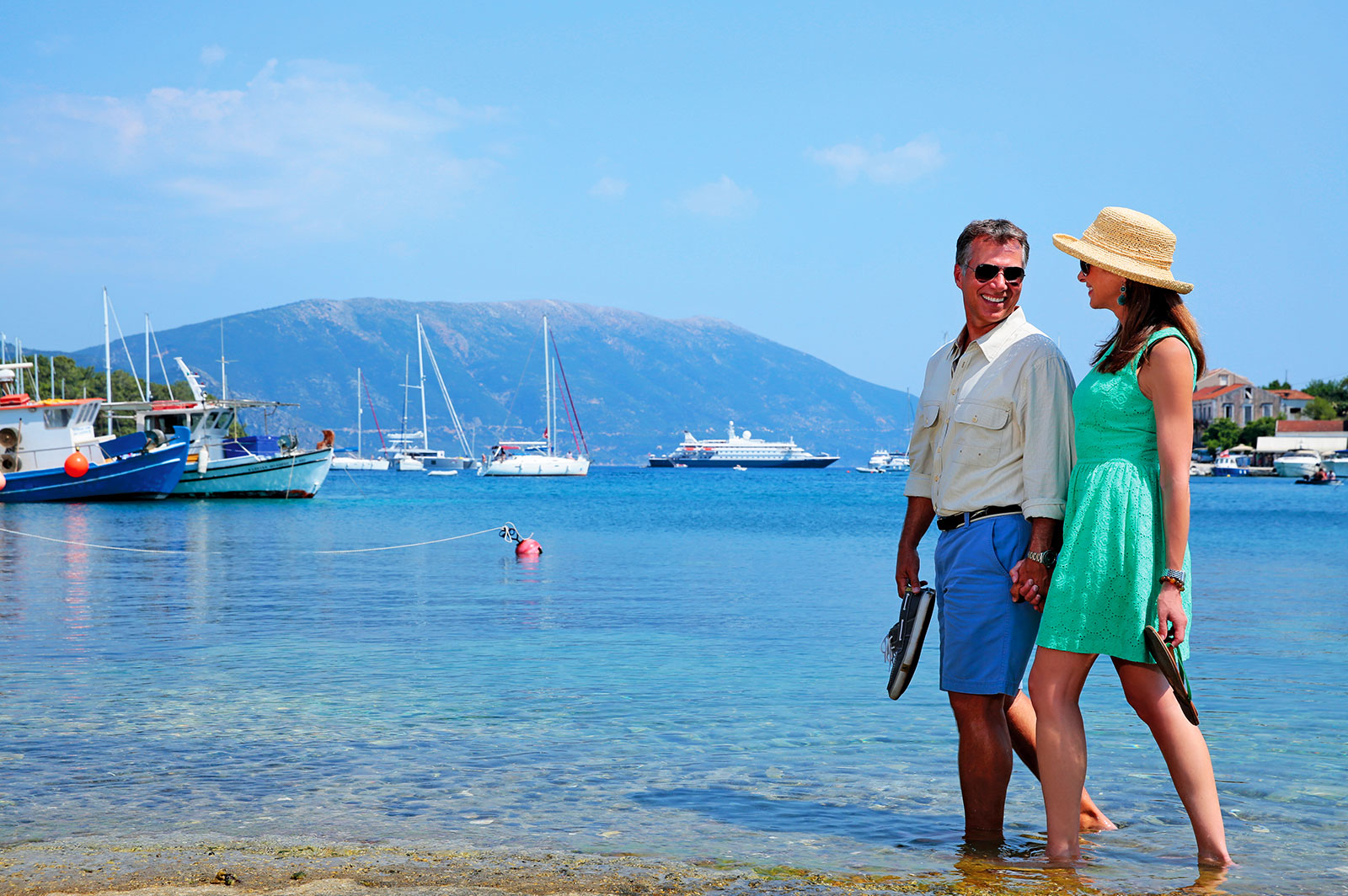
Fiskardo is a village located about 54 km north of Argostoli and a district of the city of Erisos.The coast around Fiskardo is mainly rocky with numerous pebble-beached coves. There are numerous viewpoints in the area around the village that offer panoramic views of the Ionian Sea including Daskalio island, Ithaca, northwestern Aetolia-Acarnania and the island of Lefkada.
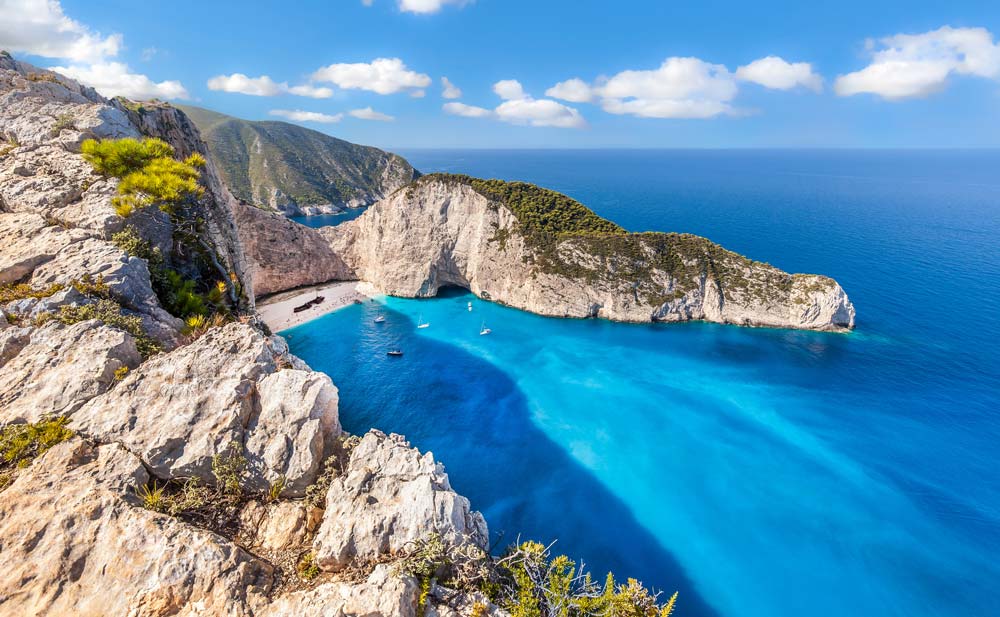
Nestled in the Ionian Sea, the island of Zakynthos is named after the son of a legendary Arcadian chief and a son of Zeus, Dardanus. The Venetians nicknamed the island “the Flower of the East,” as it boasts many beautiful beaches and rich vegetation with agricultural products such as citrus fruit, olive oil, grapes, and currants. As with other Greek islands, the culture and history of Zakynthos is extensive, dating to the Old Stone Age. Oldest mentions of the island date to the Mycenaean period, and ancient Greek poet Homer included Zakynthos in his famous works, The Odyssey and The Iliad. The island is well known as an iconic diving spot and for Navagio Beach, whose name comes from a famous shipwreck in 1980. Enjoy Porto Limnionas Beach, Blue Caves, Keri Caves, Turtle Island, Banana Beach, and the endangered Loggerhead Sea Turtle habitat in the Zakynthos Marine Park of Laganas Bay. A rich culinary tradition and wine culture can be found on the island: thicker sauces accompany dishes that incorporate more poultry and meat than other Greek cuisine. Comoutos Winery is one of the oldest running wineries, established in 1638, and the island’s most famous wine, Verdea, is one of the only two wines in Greece under the PGI Category. Guests are welcome to explore the Venetian castle on Bochali Hill, providing a panoramic view of Zakynthos Town; the Church of St. Nicholas, and St. Dionysios Cathedral.
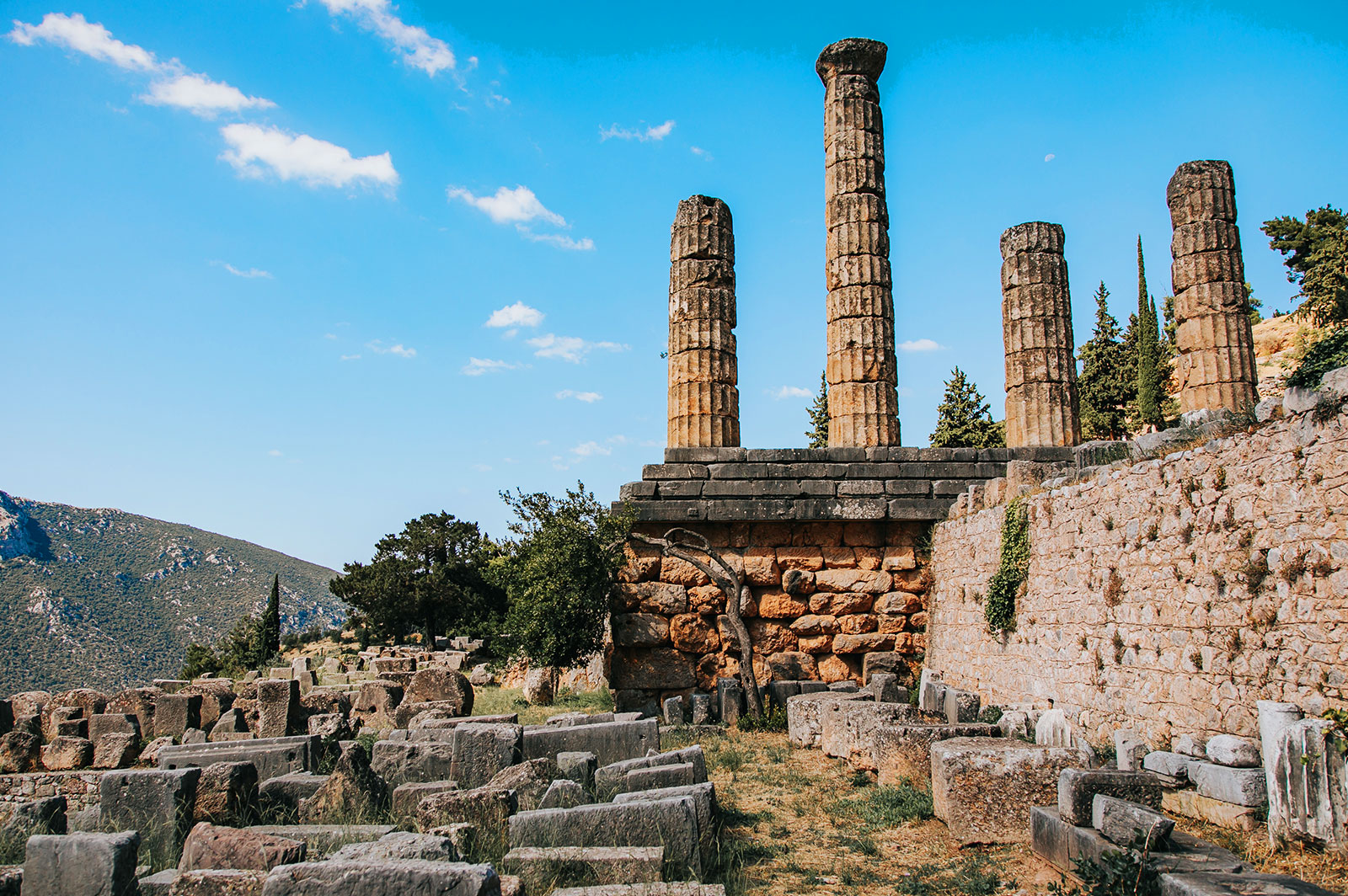
Itea is a small town situated on the north coast of the Gulf of Corinth, 2 km west of Kirra, 8 km southwest of Delphi. The town has a nice beach along with some shops, cafes and restaurants. It allows the closest access to the incredible sight of Delphi which is within the top three archeological attractions in Greece and in 1987 was inscribed as a UNESCO Heritage Site. It is believed the Zeus wanted to find the center of the Earth so he sent two eagles flying from the eastern and western extremities and where they met was Delphi – becoming the “navel/center of the earth”. SeaDream has arranged the very best guides and vehicles from Athens to enhance this incredible visit further. Your guided visit highlights the ancient Sanctuary of Apollo, where Pythia, the celebrated Oracle dwelt, the Temple of Apollo, the Sacred Way, the amphitheater, the best-preserved stadium of Greece, and the Castalia Spring, where in ancient days the pilgrims had to wash before they were allowed to consult the Oracle. In the Delphi Museum, see such treasures as the Omphalos, which marked the center of the world, and the magnificent bronze Charioteer, one of the finest pieces surviving from the 5th century BC. After the museum, there will be free time to visit the village of Delphi. SeaDream has the option of docking along the small pier in Itea or anchoring off to provide water sports options. This is dependent on availability as well as a number of guests visiting the archeological site.
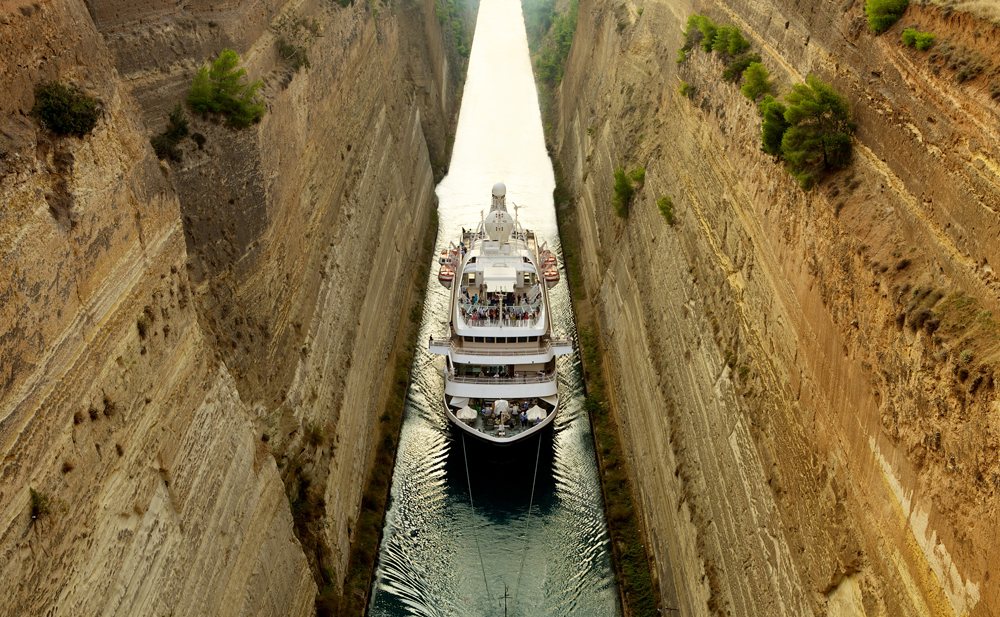
So narrow! So dramatic! You'll understand why SeaDream says "expect the unexpected" as your yacht transits the Corinth Canal. The canal was first completed in 1893, despite previous attempts from ancient times; the first plans being from 602BC. The Roman Emporer Nero actually started construction in 67AD, making the first cut himself with a golden pick. The canal we transit is 6.3 kilometres (3.9 mi) in length. Before the canal, ships sailing between the Aegean and the Adriatic had to circumnavigate the Peloponnese Peninsula adding about 185 nautical miles to their voyage.
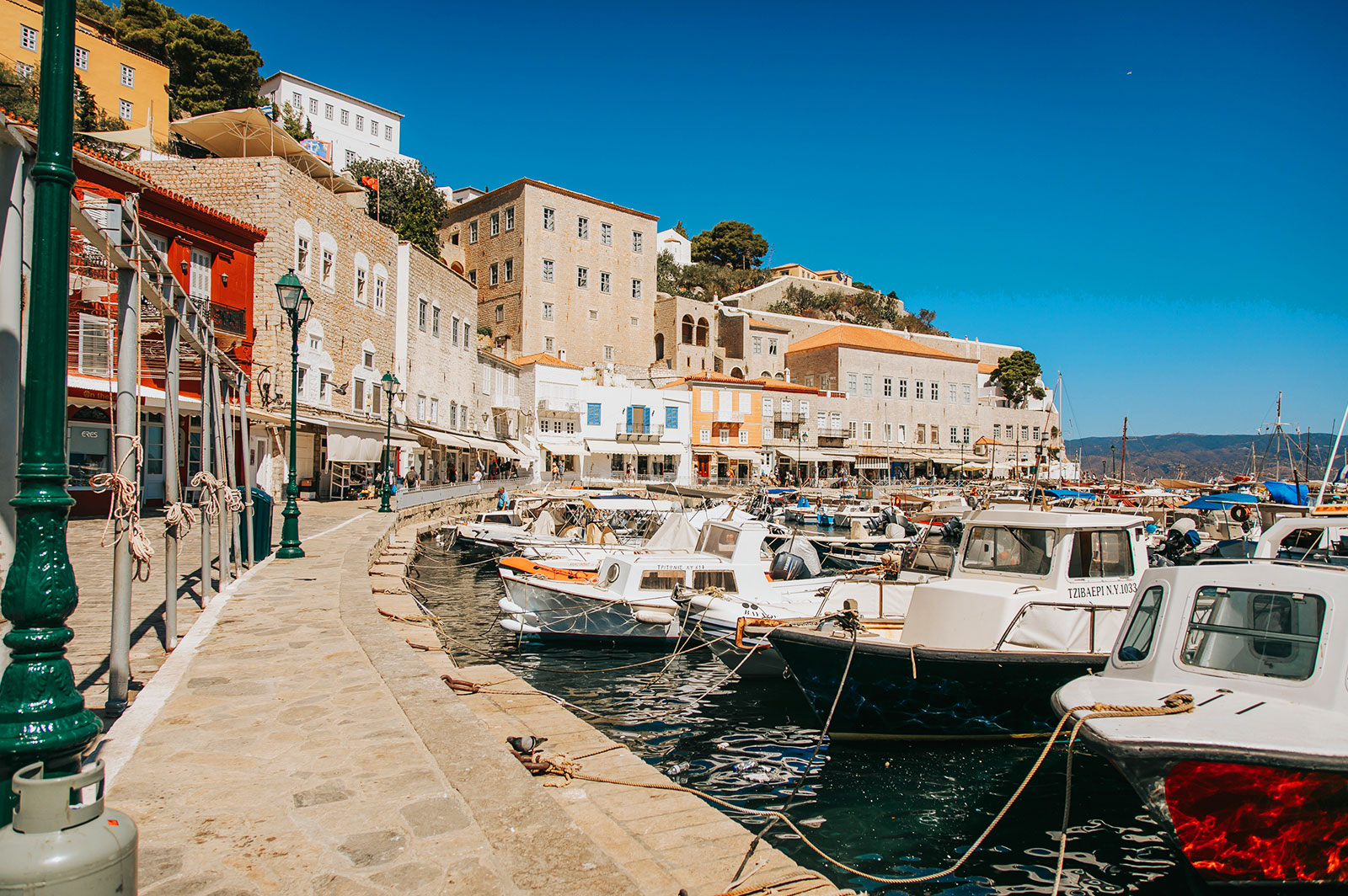
There is one main town on Hydra, known simply as "Hydra port". It consists of a crescent-shaped harbor, around which is centered a strand of restaurants, shops, markets, and galleries that cater to tourists and locals (Hydriots). Steep stone streets lead up and outwards from the harbor area. The charm of Hydra town certainly lies in her rich history, beautiful port and waterfront unspoiled by motorized vehicles. The island offers a rugged charm and some spectacular scenes and makes the perfect place for some self-exploration.
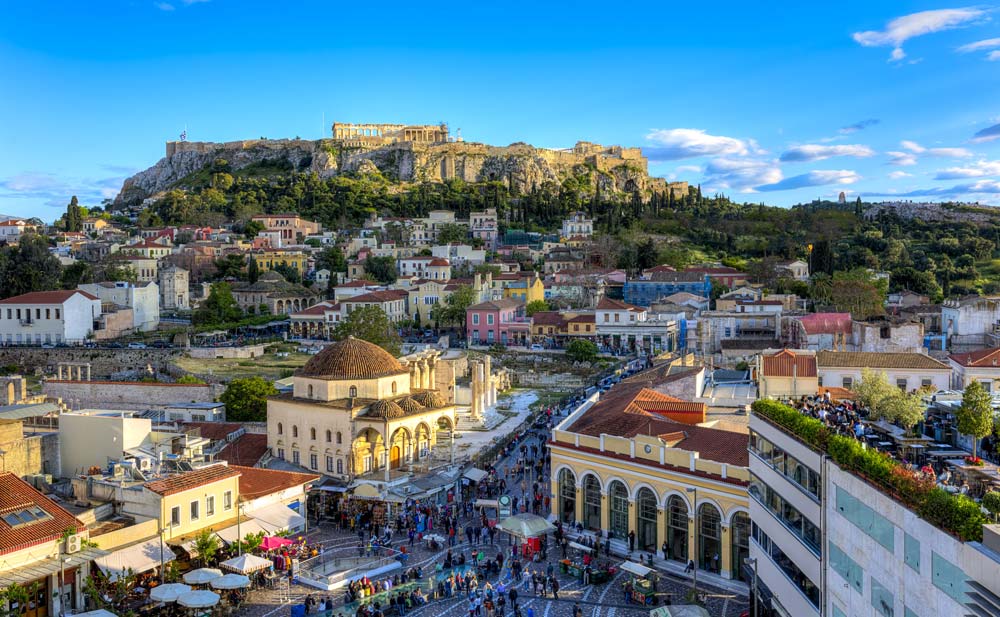
Piraeus, roughly translating to “the place over the passage”, is an important Greek port located within the Athens agglomeration, in the Attica Basin. It is 12 kilometers from the municipality of Athens, considered the fourth largest and is the third most populous amongst all the municipalities of Greece. Now a peninsula, Piraeus, originally a rocky island, was developed in early 5th Century B.C. when it was initially designated as Athens’ import and transit trade port. It is the largest marine-based shipping center of Greece, one of the largest ports in Europe, and considered the second largest passenger port in the world. Inhabited since the 26th Century, it wasn’t until the 6th Century B.C. that Piraeus began catching attention. The land of Piraeus was essentially impassable, flooded by the sea most of the year until centuries passed and the flooding ceased. By the 5th Century B.C. it became a navy base for the Athenian fleet for the natural harbors and the strategic potential they carried. Athenian general and politician Themistocles fortified Piraeus’ three harbors Kantharos, Zea and Munichia, created ship houses and completed his walls in 471 B.C., which led to the port becoming a great military and commercial harbor. There are many archaeological sites, points of interest and entertainment available in Piraeus. Most famous for its tavernas and cuisine, several popular events take place in Piraeus, such as the Ecocinema International Film Festival, the Maritime Festival, the Piraeus Rock Wave Festival and the Three Kings’ Way Festival. There are also many theaters, including the Municipal Theater, the open air Veakeio Theater, and the Menandreio Theater. Museums in Piraeus include the Archaeological Museum of Piraeus, the Merchant Shipping History Institute Exhibition, the Panos Aravantinos Decor Museum, the Georgios Averof Museum Ship and the Museum of Electric Railways. Be sure to catch the panoramic views available from the hill of Kastella, overlooking Athens and the Saronic Gulf!
Suites & Staterooms
*Single Supplement for this voyage is 200% for Yacht Club Deck 2, 3 and 4. For Commodore, Admiral and Owners Suite, a 200% single supplement rate applies.
Government, Port, Document Issuance, Handling & Service fees: $540 per guest (included)
Please Note: Fares are capacity controlled and may change without notice. The fares are per person based on double occupancy. Single and third person rates are also available. SeaDream Yacht Club strongly recommends that all guests purchase travel insurance.
Yachting Land Adventures & Activities
-
Rome (Civitavecchia) - Transfers / Private Arrangements / Pre and Post Stays / Accommodations - Civitavecchia, Italy
Description
Our Destination Specialists “Aloschi Bros” can assist with making your pre-arranged transfers, hotel accommodations and any other personalized pre or post cruise arrangements for your SeaDream cruise embarking or disembarking from Civitavecchia, Italy.
Bookings for <b>transfers</b> can be made directly on this website:
<a href="https://transfer.aloschibros.com" target="_blank">https://transfer.aloschibros.com</a>
Requests for <b>hotel accommodations and any other personalized pre or post cruise arrangements</b> can be made directly by emailing Aloschi Bros at the contact below.
Also, if you encounter any website-related questions, or issues, with your transfer booking (including non-confirmation due to limited space) please email Aloschi Bros directly for assistance.
Email: <b>rome@aloschibros.com</b> "OR" <b>rome11@aloschibros.com</b>
Phone: +39.06.420.20.498
An Aloschi team member will contact you with details within three days of receiving your email request.Notes
Duration
N/A hour(s)
Price
(USD)
-
Capri - Discovering The Island of Love
Description
This Yachting Land Adventure has it all! In love or not, we recommend that you sign up early for this annual favorite! Begin your discovery of "The Island of Love" by stepping from your SeaDream yacht into a motor launch to explore the island's dramatic eastern coastline. See the famous Faraglioni Rocks, cruise into a coral cave, and explore the rugged vistas of Capri's tiny coves. As you step back ashore, head next to the high village of Anacapri in high style via your waiting convertible touring car** (Specifically made for the island of Capri – It’s a Caprisian Convertible!). Once in Anacapri, board a chairlift that takes you skimming over vineyards to the top of Mt. Solaro and its magnificent vistas. After your visit hop back in your car to wind down to Capri town for a guided tour of the main center, before returning to the yacht. This is an excellent overview of one of the most visited islands in the world – enjoy every moment!
Notes
This adventure involves climbing in and out of a motor launch. The chairlift ride is "optional" and not advised for those with a fear of heights or walking difficulties. Opting out of the chairlift ride allows guests to explore local shops and rejoin the group later. A minimum participation is required to operate all Yachting Land Adventures and some have limited capacity. **The convertible touring cars are limited and if not available, a minibus will be substituted. All adventures in the SeaDream Yachting Land Adventures program are subject to change. Final departure times are published onboard. Tour sequence can vary to avoid congestion.
After the Global Pandemic and tourism shutdown, we are experiencing higher than normal tourists in these popular destinations during the peak season (June, July, and August).Duration
5 hour(s)
Price
199 (USD)
-
Capri - Highlights of Capri & Wine tasting
Description
Experience an unforgettable day on the Island of Capri while seeing the highlights and tasting the flavors of wine with traditional Italian food at a local vineyard.
Meet your private guide at the pier side for an unforgettable day in Capri, tasting and discovering the highlights of the island. A short walk to the nearby mini coaches, which take you to the higher village of Anacapri. Here you will take a chair lift up to explore Mt Solaro; then travel down in the chair lift for breathtaking views of the bay of Naples.
Next board the mini coaches and drive to the La Scala Fenicia Vineyard. The island of Capri was once a favorite destination of the Romans. Part of that history can be seen in the wine cellar of Scala Fenecia, built inside an ancient Roman cistern. Its thick walls and vaulted ceiling provide an ideal climate and temperature for wine preservation. You will experience Roman wine history firsthand and taste delicious Capri wines while inside a Roman Cistern before returning to your yacht.Notes
This Yachting Land Adventure must be booked 72 Hours (3 days) prior to arrival in the port to confirm its operation during your voyage. Please book on the Seadream.com website, or onboard, early to avoid disappointment. Cancellations after the deadline are non-refundable.
Please wear comfortable walking shoes. A minimum participation is required to operate all Yachting Land Adventures, and some have limited capacity. Final departure times will be published onboard. When Capri is the first port of call on the itinerary; this tour must be prebooked on the website prior to embarking the yacht.
After the Global Pandemic and tourism shutdown, we are experiencing higher than normal tourists in these popular destinations during the peak season (June, July, and August).Duration
4 hour(s)
Price
239 (USD)
-
Amalfi - NAT GEO DAY TOUR: A Deep Dive into Ancient Roman Life: Oplontis and Pompeii
Description
Immerse yourself in the leisure life of the ancient Roman elite as you journey through frescoed villas and the sprawling ruins of Pompeii. Marvel at still-standing UNESCO-protected forums, theaters, baths, restaurants and more! You’ll also learn about lesser-known sites, such as Casa della Regina Carolina, where researchers are studying the daily domestic activities of the Roman people.
Begin your journey, by boat, to the small port city of Torre Annunziata, where you’ll leave bustling roads and concrete facades behind as you descend below street level to ancient Oplontis. As a protected UNESCO World Heritage Site, the area and its two sprawling villas boast some of the best-preserved wall paintings of the Roman period.
Your guide—an expert archeologist—will offer historical, cultural, and architectural context for the painted wonders around you. Marvel at tiled mosaics and floor-to-ceiling frescos finished in the Pompeiian style with deep azure blues, bright oranges, and sunny golds. As you explore recently reconstructed halls and columned atriums, you’ll discover three-dimensional painted landscapes next to still-life scenes rendered by artists thousands of years ago.
Continue a short distance away to the foothills of Mt. Vesuvius and the ruins of Pompeii, an ancient city preserved by volcanic eruption. After a quick lunch featuring a recreated Roman meal, stroll down cobblestone streets to the Forum. Here, Romans once discussed politics, sold goods, and gathered for worship. Follow ancient paths to grand spaces like the House of the Faun with its rich mosaics and green gardens. Sit in the arena of the Theater and study the colossal columns of the Basilica. You’ll also visit areas of everyday life like the baths, taverns and the Thermopolium, where Romans brought their families for quick bites.
On your final stop within these winding ruins, you’ll find Casa della Regina Carolina, one of the ancient city’s largest homes located in an elite neighborhood near the Forum. Gain fascinating insight into the ongoing research started by National Geographic Explorer Caitlin Ellis Barret as you learn about the house and the daily domestic activities of its vacationing socialites.Notes
The tour sequence can vary. This Yachting Land Adventure must be booked 48 Hours (2 days) prior to arrival in the port to confirm its operation during your voyage. Please book on the Seadream.com website, or onboard, early to avoid disappointment. Cancellations after the deadline are non-refundable. A minimum participation is required to operate all Yachting Land Adventures and some have limited capacity. All adventures in the SeaDream Yachting Land Adventures and Nat Geo programs are subject to change. Final departure time will be announced on board. Be sure to wear comfortable walking shoes.
Duration
6.45 hour(s)
Price
389 (USD)
-
Amalfi - Ravello, the Balcony of the Amalfi Coast
Description
Discover Ravello, the Balcony of the Amalfi Coast including a SeaDream welcome aperitif at a heavenly retreat between sea and sky, followed by an informative walking tour of Amalfi.
Perched on a 350-foot-high cliff overlooking the Gulf of Naples, is the intimate hillside village of Ravello. Travel by minibus up the mountain on this Yachting Land Adventure to discover Ravello's charms and visit Villa Rufolo with the garden that inspired Richard Wagner. Walk with your guide through this lovely village and enjoy approximately 45 minutes on your own to explore its shops and peek inside the cathedral, founded in 1086, which contains two medieval pulpits, Roman sarcophagi & paintings by southern Renaissance artist Andrea da Salerno.
Afterwards, enjoy a welcome aperitif at a local hotel in Ravello with outstanding views of the Amalfi coastline before driving back to Amalfi town. Upon arrival in Amalfi, the guide will take you on a walking tour of the main center including a visit of the cathedral and its cloister before returning to the yacht.Notes
A minimum participation is required to operate all Yachting Land Adventures and some have limited capacity. All adventures in the SeaDream Yachting Land Adventures program are subject to change. Final departure time will be announced on board.
Guests must be able to walk approximately a half mile during approximately one hour, over various surfaces of cobblestone streets with more than one hundred steps up and steep inclines. Comfortable clothing and walking shoes are recommended. To visit the Cathedral and Cloister in Amalfi, conservative attire with no exposed shoulders or knees is recommended. Short pants, tank tops and revealing clothing are not acceptable. Dense traffic congestion can be anticipated and may affect the duration of the excursion. After the Global Pandemic and tourism shutdown, we are experiencing higher than normal tourists in these popular destinations during the peak season (June, July, and August). Tour order may vary, but the mentioned sites will be included regardless.Duration
4 hour(s)
Price
229 (USD)
-
Amalfi - Uncover Ancient Pompeii
Description
Discover the ancient ruins of Pompeii and find out how the Ancient Romans lived and worked this informative guided tour. A flourishing civilization buried for 1,700 years, Pompeii is possibly the most famous excavation site in the world. Brought to life by your guide, now you can see how citizens of the greatest empire of the world lived and loved, worked and played, ate and drank—and met their fateful death.
Your journey begins as you travel from Amalfi through mountain roads toward Pompeii while admiring Mount Vesuvius, the still-active historic volcano located 15 miles southeast of Naples. Entering Pompeii by foot at the Sea Gate you are soon in the Agorà, surrounded by temples, porticoes, and law courts.
20,000 people lived in this provincial town, of whom 2,000 perished in the catastrophic eruption of Vesuvius in 79 AD. Twenty feet of ashes and pumice stone covered Pompeii, much of which has been removed during the last 200 years to reveal details of everyday life. The mosaic floors and the brilliant frescoes that so delighted the Pompeians shine forth in all their undiminished glory. Explore baths and theaters, the wrestling ground, and luxurious villas and gardens, complete with plaster casts of the locals at the moment of Vesuvius’s eruption. At the end of your experience, reboard your coach for the drive back to Amalfi where you are welcomed back on board your yacht.Notes
There is free time at the end of this excursion to have a quick snack at Pompeii. Due to possible traffic delays, your return to the yacht may be after lunch; however, there is 24-hour meal service at the bar. After the Global Pandemic and tourism shutdown, we are experiencing higher than normal tourists in these popular destinations during the peak season (June, July, and August).
Requires extensive walking over uneven surfaces; not suitable for guests with walking disabilities or guests who use a wheelchair. Wear comfortable walking shoes; bring a hat and sunscreen. Due to security reasons, no backpacks and big bags are allowed inside Pompeii excavations. A minimum participation is required to operate all Yachting Land Adventures, and some may have limited capacity. All adventures in the SeaDream Yachting Land Adventures program are subject to change. Final departure times will be published on-board.Duration
5.5 hour(s)
Price
229 (USD)
-
Taormina (Etna) Sicily - Ascent of Mt. Etna
Description
Board 4x4 vans for a portion of the ascent to one of the greatest European Volcanos - Mt. Etna. Admire the unique volcanic scenery and at the base of the crater where a alpine guide will escort you to the 2,800 meter level for magnificent views of the volcanic craters of Etna!
Depart from the port for a dramatic drive via air-conditioned motor coach to the slopes of Europe's largest active volcano. The road winds its way through small villages, lemon groves, orchards, vineyards, chestnut and pinewoods. Gradually encounter the hardened lava fields scattered with volcanic cones. Enjoy the view from the Silvestri Craters located at an altitude of 6200 feet and surrounded by hardened lava flow. Appreciate this eerie, unique scenery and travel to the next level by cable car. Finally, board 4x4 vans for the drive to the base of the crater, to meet Alpine guides who lead the twenty-minute walk up as close as possible to the crater's edge. Then it's back down, winding through the fields and villages for a return to Taormina and the SeaDream yacht.Notes
A minimum participation is required to operate all Yachting Land Adventures and some have limited capacity. All adventures in the SeaDream Yachting Land Adventures program are subject to change. Final departure time will be announced on board.
Be sure to wear comfortable hiking shoes, as some of the uphill walking will be on loosed volcanic shingle. Participants must be in good physical condition due to the high altitude. Also, it is important to bring a warm jacket, as the wind on top of the mountain can be strong and cold. Jackets and hiking shoes/socks can be rented at the tram stations. There is a restaurant at the crater base and time available where guests can purchase their own snacks independently or a box lunch may be provided depending upon the departure time.Duration
5.5 hour(s)
Price
329 (USD)
-
Taormina (Etna) Sicily - Viagrande & Benanti Winery
Description
Enjoy the unique scenery of the greatest European volcano and enjoy a visit plus wine tasting at one of the best known vineyards in the region.
The excursion begins with a brief drive through the town of Naxos, founded by Greek colonizers in 8th century BC. Ride along the flanks of Mt Etna and continue to the village of Viagrande, situated on a hill on the slopes of Mount Etna. Viagrande is famous for being mentioned in the first novel (“Nedda”) of the Sicilian writer Giovanni Verga.
This village is also known for its vineyards and especially for its gastronomic traditions. The tour continues to the Benanti Winery Monte Serra estate for a sample of several the winery's finest vintages, paired with tastings of local cheese, sun-dried and fresh tomatoes, green and black olives, salami and bruschetta. The winery visit also includes the vineyard and the historical oak barrel room.
From Benati Winery, ride back down to Naxos pier where the SeaDream yacht awaits.Notes
If Benanti Winery in Viagrande is not available at the time of your stop in Taormina; another winery in Linguaglossa will be visited instead. A minimum participation is required to operate all Yachting Land Adventures and some have limited capacity. All adventures in the SeaDream Yachting Land Adventures program are subject to change. Final departure time will be announced on board.
Duration
4.5 hour(s)
Price
249 (USD)
-
Fiskardo, Kefalonia - Best of Cephalonia
Description
Revel in the highlights of Cephalonia such as the amazing Melissani Lake and the remarkable cave of Drogarati, while enjoying scenic views and a Greek lunch in a Greek village.
Cephalonia Island is famous for its unique geological phenomena such as caves and underground lakes.
Starting from Fiskardo, you take the main road and head south to the small village Karavomylos where the mysterious, 40,000-year-old, under-ground lake of Melissani is located. After an earthquake, the ceiling of the cave fell in, creating what may be one of the most impressive sights you have ever seen. Boats will wait for you at the shore to take you around the blue-green waters of the lake and the boatmen will amuse you as they will compare the stalactites to various animals in a humorous way.
After visiting the lake, you will travel to the close by Drogarati Cave. The Cave was Discovered 300 years ago when a part of the cavern was destroyed by an earthquake. It descends to a depth of 200 feet and features an impressive interior of stalactites and stalagmites. Reaching the cavern’s interior by a spiral staircase, you will stand awestruck at the scene that greets you, accentuated by carefully placed, concealed lighting. A second chamber, called the Chamber of Exaltation, boasts superb acoustics and hosts concerts for many people.
Heading north, you pass by the area of Myrtos Bay where there is a photo stop and glimpse of the most beautiful and unique beach in Greece. Next stop is at the tiny picturesque village of Assos, built on the neck of an enchanting peninsula. Admire the tiny houses roofed with red tiles and the Venetian fortress crowing the hilltop of the village. Here you can stroll the picturesque little streets and browse the shops during free time, after enjoying a delicious Greek style lunch at a village restaurant before heading back to the SeaDream Yacht in FiskardoNotes
A minimum participation is required to operate all Yachting Land Adventures, and some may have limited capacity. All adventures in the SeaDream Yachting Land Adventures program are subject to change. Final departure times will be published on-board.
Duration
7 hour(s)
Price
239 (USD)
-
Fiskardo, Kefalonia - Fiskardo Coastal Boat Adventure
Description
Have you always dreamed of commanding your own vessel along the coastline of a Greek Island? Well, now is your chance to do just that, and with a friend where you can enjoy a light picnic in your own small private motorboat while cruising off the Fiskardo coastline.
An instructor will meet you pier side and escort you to a smaller nearby pier to be assigned your private boat. The instructor makes sure everyone is comfortable onboard before departing independently to explore. On this Greek coastline adventure, you will encounter the caves, coastline, and beautiful beaches of Fiskardo at your own pace while enjoying a delightful tapas style picnic of tasty treats onboard. Beaches on this part of Kefalonia are of the pebbly variety - they are not sandy. The boats are ideal for maneuvering into the sheltered bays for swimming where the sea is usually calm. Whether basking on the beach or exploring the depths, rest assured that you'll find crystal-clear cool water surrounding you.
This is a fantastic opportunity to explore the northern tip of Kefalonia and the Errisos peninsula, with its alluring and varied coastline. Your boat is well equipped take you places that cannot be reached by local roads on this fun Yachting Land Adventure.Notes
The price of this tour is per boat (based on 2 guests per boat) and only 1 guest needs to purchase a ticket. These boats are easy to drive, and no previous boating experience is required. The experienced staff will provide the necessary instructions on boat handling, a map and any advice needed before you depart on your adventure. Please book your boat early as they are limited, and you would not want to miss out.
Wear a hat and sunscreen. If you plan to swim, wear your swimming suit and bring a towel from the yacht. One guest per boat should carry with him/her a mobile phone with a valid number to be in contact with the boat instructor in case of any assistance needed during the sailing time. Operation is subject to weather & sea conditions.Duration
4 hour(s)
Price
669 (USD)
-
Zakynthos - Caretta-Caretta (Sea Turtle) Cruise
Description
Cruise from Zakynthos Island in the area where the famous Caretta-Caretta turtles live and visit where they lay their eggs in the sand. On this Yachting Land Adventure, you have the chance to admire the beautiful seascapes of the island from the sea. Board your coach from Zakynthos port for a 30-minute drive to the Agios Sostis pier. Here you will board the local boat to start your short cruise around the island of Zakynthos. Also, this cruise will visit the island of Marathonisi with gorgeous beaches and crystal-clear water. Marathonisi is also the island where the famous sea turtles Caretta Caretta go to lay their eggs in the sand. After visiting Marathonisi, the boat will head to the caves of Keri for a swim stop. Please note that the tour sequence and content of this Adventure may change, because it is weather dependent upon the conditions of the day. After the cruise you will reboard the coach for the return journey to Zakynthos town.
Notes
Be sure to bring your towel, swimming suit, a sun hat and wear non-slip shoes. A Seadream Box Lunch will be enjoyed onboard at your leisure. A minimum participation is required to operate all Yachting Land Adventures and some have limited capacity. All adventures in the SeaDream Yachting Land Adventures program are subject to change. Final departures times will be published onboard.
Duration
4 hour(s)
Price
169 (USD)
-
Zakynthos - Panoramic Zakynthos, Winery & Olive Press
Description
Explore Zakynthos on this panoramic drive of an island rich in beauty as well as in culture and tradition. On this tour you have the opportunity to admire the beautiful landmarks and gain an insight into the island’s culture. Departing the port by comfortable motorcoach you pass by St Dennis Cathedral (Patron saint of the island) and continue north to the area of Katastari where a photo stop will be made for a panoramic view of the salt flats of Alykes.
Conintuing on your panoramic drive you can admire the beautiful landscapes of the island. The first stop will be at the scenic Grampsas Winery Estate where you will get acquainted with the vineyard and the Zakynthos wine world. You will walk through the cellar to see where the wines age and mature; plus enjoy a tasting of some of their fine wines with snacks.
Following the winery visit you continue down the road for a visit of a modern olive oil press mill. The Aristaion Mill is a traditional family business located in Lithakia Zakynthos. Their history began in 1850 with a traditional animal movement press, part of which survives still today. They later changed to metal and then hydraulic presses. As technology evolved, in 2008 they upgraded once again to new technology with eco-drive for processing the olives. A guided tour will explain to you step-by-step the production process. Learn about the production of olive oil from the wooden press in the 18th century to the modern centrifuge machines, and two modes of today. At the end of the visit you will enjoy a tasting of olive oil with homemade bread and local olives. An olive oil soap will be given to you as a gift before you depart the olive oil press. Then reboard your coach for the return journey back to Zakynthos town.Notes
A minimum participation is required to operate all Yachting Land Adventures and some have limited capacity. All adventures in the SeaDream Yachting Land Adventures program are subject to change. Final departures times will be published onboard.
Duration
3.5 hour(s)
Price
179 (USD)
-
Itea (Delphi) - Incredible – UNESCO Awarded Delphi
Description
Discover Delphi, considered by ancient Greeks to be the center of the world, and visit its well-preserved ruins including the Sanctuary of Apollo. Also explore the museum containing sculptures and artifacts excavated from the Oracle and among its treasures a unique Bronze Charioteer.
Travel from Itea in your air-conditioned motor coach for approximately 45 minutes to reach the impressive site of Delphi. Situated on the slopes of Mt. Parnassus, at a height of 700 meters, you can understand why Delphi was once believed to be the centre of earth. The guided tour starts at the Sanctuary of Apollo, as you follow the paved sacred way to reach the Doric Temple of Apollo. In its Adyton the High Priestess " Pythia " sat on a tripod and delivered the oracles. The Theatre and the Stadium were used for the main events of the Pythian Festival. To the right of the entrance to the Sanctuary is the Kastalian Fountain, where Pythia washed before speaking her prophecies.
Across and below the road from the spring is the Marmaria or Sanctuary of Athena, with the conspicuous building of Tholos. Your visit continues to the Museum, containing a rare and exquisite collection of archaic sculpture including the world-famous Bronze Charioteer. After visiting the site and the museum you will board your coach for your return drive to the pier.Notes
To appreciate this beautiful sanctuary of Apollo, it is necessary to walk up a gently sloped path known as the “Sacred Way”. Please wear flat and comfortable walking shoes. Sun screen and hats are recommended. Water bottles will be available at the gangway, please make sure you carry a bottle with you.
A minimum participation is required to operate all Yachting Land Adventures and some have limited capacity. All adventures in the SeaDream Yachting Land Adventures program are subject to change. Final departure time will be announced on boardDuration
4 hour(s)
Price
249 (USD)
-
Itea (Delphi) - Mountain Biking in Parnassos Wild Park
Description
Take a refreshing mountain bike ride within the National Park of Mount Parnassos. Start with a coach transfer to the archaeological site of Delphi. Just across from the Delphi Archaeological Museum, pick up a bike and start exploring together with a professional bike instructor. Follow a unique descending path that combines both alpine landscapes and forest areas. Stop for a picnic in the forest to taste local delicacies. At the end of the cycling, return via private vehicle to Itea pier and the SeaDream yacht.
Notes
Please wear comfortable clothing and good, closed toe shoes as well as sun screen. Guests should be in good physical condition in order to participate in this land adventure as it involves extensive biking on uneven terrain. Most of the biking is down hill. Several stops will be made along the way.
A minimum participation is required to operate all Yachting Land Adventures and some have limited capacity. All adventures in the SeaDream Yachting Land Adventures program are subject to change. Final departure time will be announced on boardDuration
3 hour(s)
Price
239 (USD)
-
Corinth Canal Transit - Transiting The Corinth Canal
Description
So narrow! So dramatic! You'll understand why SeaDream says "expect the unexpected" as your yacht transits the Corinth Canal.
The Corinth Canal was built in the late nineteenth century and created a new sea route by linking the Corinthian
and Saronic Gulfs. Until that time, ships sailing between the Aegean and the Adriatic had had to circumnavigate the Peloponnese Peninsula adding about 185 nautical miles to their voyage. However, in antiquity the Greeks had devised a way of solving the problem of communications between the two seas. In the late seventh or early sixth century BC, the tyrants of Corinth constructed a paved road called the Diolkos, which led from Schinous on the Saronic Gulf to Poseidonia on the Gulf of Corinth. The Dioikos was 3-3.5 m. wide, and it was paved with blocks of limestone set in a deep layer of sand and gravel. Along this ran the olkos vehicle on which ships were borne overland from one side of the Isthmus to the other. Sections of the Diolkos can still be seen today; the deep parallel ruts in the road, 1.50 m. apart, are the marks left by the wheels of the olkos.
The ancient Greeks had of course, considered the possibility of digging a canal through the Isthmus. The first to look into the matter was Periander, tyrant of Corinth, who drew up a plan for a canal in 602 BC. Subsequent planners included Demetrius Poliorcetes, Julius Caesar and Caligula. These plans were later adopted by Nero, who in 67 AD announced to the spectators at the Isthmian Games that he was going to join the two seas by digging a canal through the Isthmus; indeed, he went so far as to cut the first turf himself, with a golden pick, and to carry the first basket of earth on his back. But his plans came to nothing, as did those of Herodes Atticus, the Byzantines and the Venetians in later times.
The canal we see today was built in 1882 -1893 by Greek and French engineers using the most advanced machinery of the day. General supervision of the enormous undertaking was in the hands of General Stepan Tupp, aide-de-camp to the King of Italy. The project was completed by the Greek Corinth Canal Company.
The canal is 6,343 m. in length. It has a width of 24.60 m. at surface level and 21.30 m. at the seabed, and in some places its sides are 79 m. high. The canal is crossed by road and railway bridges, while communications between Central Greece and the Peloponnese are also served by two ferries in the form of submersible bridges, one at either end (Poseidonia and Isthmia).Notes
Duration
N/A hour(s)
Price
(USD)
-
Hydra - Charming Hydra Stroll
Description
Discover the numerous beauties of Hydra on foot since no vehicles other than “donkeys” are allowed on this tiny island and enrich your photo collection with stunning pictures.
The charm of Hydra town certainly lies in her rich history, beautiful port and waterfront unspoiled by motorized vehicles. However the island itself also offers a rugged charm and some spectacular scenes.
Together with your guide start your walking exploration through the island's historical landmarks. The first stop will be the Hydra Museum Historical Archives where you may admire 19th century paintings of considerable artistic value as well as rich documental and photographic material detailing the long maritime tradition and history of the island.
Continuing your stroll around the port you will visit the Church of the Dormitian, which houses splendid icons, chandeliers and other offerings from the wealthy seafarers of the island. It is even said one of the chandeliers was stolen from Louis XIV and given to the church. Enjoy a coffee or a refreshment together with Hydra's local sweet " amygdaloto" at a local coffee shop.
Next, take the road uphill to reach Koudouriotis Mansion, one of the finest examples of the traditional 18th and 19th century architecture of Hydra. Built in 1780 by the ship owner Lazaros Koundouriotis, it now houses various items from the National Historical Museum of Athens, such as traditional costumes, jewellery, fine embroideries, pottery and wood-carvings. Enjoy a leisurely walk-through Hydra's little alleys and impressive stone houses before you return back to the yacht.Notes
This tour sequence can vary to avoid congestion at the venues. A minimum participation is required to operate all Yachting Land Adventures and some have limited capacity. All adventures in the SeaDream Yachting Land Adventures program are subject to change. Departure time will be announced on board.
Duration
3 hour(s)
Price
179 (USD)
-
Hydra - Hydra Walking and Swimming
Description
Take a walk through the hidden paths of Hydra town and along the coastline which lead to the beautiful Vlychos beach and reward yourself with a refreshing swim in the clear blue sea.
Walking in Hydra is the best way to explore its natural beauty. Walk with an experienced local guide from Hydra harbour along coast road passing Avlaki Bay, to the small fishing harbour, Kamini. Stop for photos and continue to Vlichos village and then along a coastal path to Vlychos beach for a swim in the crystal sea water. You will also enjoy a refreshment before returning to the pier by a local boat.Notes
Please wear good walking shoes or sturdy sneakers (flip flops or sandals are not recommended), bring a swimming suit and a hat and sun screen, plus water shoes due to the rocky beach. Towels and water will be available at the gangway. This walk is approximately 2 kilometers (approximately 1.25).
A minimum participation is required to operate all Yachting Land Adventures and some have limited capacity. All adventures in the SeaDream Yachting Land Adventures program are subject to change. Departure time will be announced on board.Duration
3 hour(s)
Price
159 (USD)
-
Athens (Piraeus) - Private Transfer - SIXT ride
Description
For seamless ground transportation to or from your SeaDream Yacht, we’ve partnered with SIXT ride to offer premium pre-arranged transfers. Whether you require an airport pickup, private chauffeur service, or on-demand transport, SIXT ride provides a variety of high-quality vehicle options with professional drivers, transparent pricing, and cashless convenience.
Notes
To arrange your transfer, please visit https://www.sixt.com/ride/partners/seadream
Duration
hour(s)
Price
(USD)
Prices are per person, in USD. Duration is in hours.
Testimonials
We really had a great time which far exceeded our expectations. Mr & Mrs AmbroseTexas
Cuisine always delicious & freshly prepared – amazing crew! We can't wait to come back again. Mrs Fiona L.Great Britain
